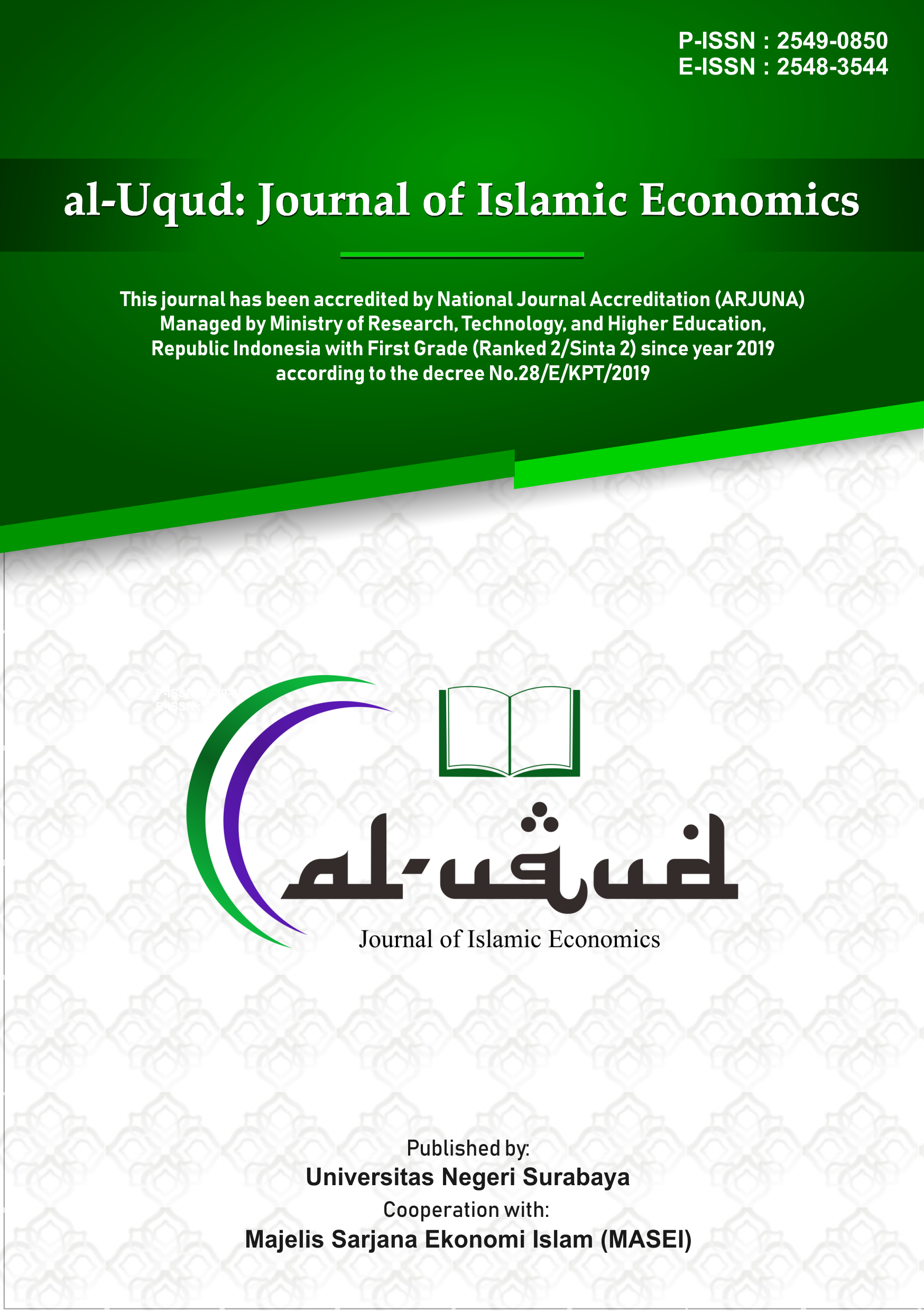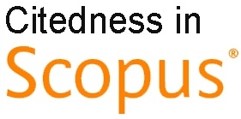Reducing family poverty through an Islamic women’s empowerment strategy in Indonesia: An analytical network process approach
DOI:
https://doi.org/10.26740/aluqud.v6n2.p206-219Keywords:
Empowerment model, Women empowerment, Family poverty, Islamic perspectiveAbstract
This study is intended to develop a strategy for the socio-economic empowerment of women from low-income families based on an Islamic perspective. The research was motivated by Indonesia’s low score on the Gender Inequality Index (GII) compared to other countries, indicating the gap between men’s and women’s empowerment in Indonesia. The percentage of women who become the heads of poor households increases yearly. This qualitative study uses the Analytical Network Process (ANP) to test the social welfare measures for low-income families carried out by governments, Islamic philanthropic institutions, and Islamic microfinance institutions. As many as fifteen respondents involved in the ANP method were experts on the studied problems, namely regulators, practitioners, and academics. The research results indicate that the main priority issue developing women’s empowerment is the development of partnership networks. In the next stage, the experts concluded that business assistance and mental-spiritual development were the main priorities for empowering women and reducing family poverty. The provision of financial access is the last priority. One implication of this study is that the empowerment program for women from low-income families must be holistic, e.g., by forming a Group Lending Model (GLM) with a modification of the majlis ta'lim (Islamic community discussion group).
References
Anis, F. M. (2016). Effectiveness Of Zakat Based Programs On Poverty Alleviation and Economic Empowerment Of Poor Women: A Case Study of Bangladesh. Journal of Islamic Monetary Economics and Finance, 1(2), 229-258. https://doi.org/10.21098/jimf.v1i2.539
Aslam, N. M. (2014). Role of Islamic Microfinance in Poverty Alleviation in Pakistan: An Empirical Approach. International Journal of Academic Research in Accounting, Finance and Management Sciences, 4 (4), 192-205. http://dx.doi.org/10.6007/IJARAFMS/v4-i4/1288
Bank Indonesia, T. (2016). Buku Usaha Mikro Islami. Jakarta: BI Institute.
Beik, I. S. (2015). Economic Role of Zakat in Reducing Poverty and Income Inequality : Case Study in The Province Of DkI Jakarta, Indonesia . Germany: LAP Lambert Academic Publishing.
Chaudhry, I., & Nosheen, F. (2009). The Determinants of Women Empowerment in Southern Punjab (Pakistan): An Empirical Analysis. European Journal of Social Sciences , 10(2), 216-229.
Durrani, K. M., Usman, A., Malik, M. I., & Ahmad, S. (2011). Role of Micro Finance in Reducing Poverty: A Look at Social and Economic Factors. International Journal of Business and Social Science, 2 (2. 21, 138-144.
Gupta, M. (2020). Role of NGOs in Women Empowerment: Case Studies from Uttarakhand, India . Journal of Enterprising Communities: People and Place in The Global Economy, 123-140. https://doi.org/10.1108/JEC-04-2020-0066
Haque, M. M., Islam, T. M., Tareque, M. I., & Mostofa, M. G. (2011). Women Empowerment or Autonomy: A Comparative View in Bangladesh Context. Bangladesh e-Journal of Sociology, 8(2), 15-26.
Hasan, K. (2010). An Integrated Poverty Alleviation Model Combining Zakat, Waqf and Microfinance. Seventh International Conference - The Tawhidi Epistemology: Zakat and Waqf Economy.
Islam, M. S. (2021). Role of Islamic Microfinance in Women's Empowerment: Evidence from Rural Development Scheme of Islami Bank Bangladesh Limited. ISRA International journal of Islamic Finance, 13(1), 26-45. https://doi.org/10.1108/IJIF-11-2019-0174
Kushardajani, K. (2019). Social and Economic Empowerment for Village Women as a Strategy of Village Development. The Indonesian Journal of Planning and Development, 4(1), 1-6. https://doi.org/10.14710/ijpd.4.1.1-6
Mahmood, S., Hussain, J., & Matlay, H. Z. (2014). Optimal Microfinance Loan Size and Poverty Reduction Amongst Female Entrepreneurs in Pakistan. Journal of Small Business and Enterprise Development, 21(2), 231-249. https://doi.org/10.1108/JSBED-03-2014
Maika, A., & Kiswanto, E. (2007). Pemberdayaan Perempuan Miskin Pada Usaha Kecil di Pedesaann Melalui Layanan Lembaga Keuangan Mikro. Jurnal Populasi 18 (1), 65-84. https://doi.org/10.22146/jp.12073
Mamun, A. A., Wahab, S. A., & Malarvizhi, C. (2010). Impact of Amanah Ikhtiar Malaysia's Microcredit Schemes on Microenterprise Assets in Malaysia. International Research Journal of Finance and Economic, 60, 144-154. http://dx.doi.org/10.2139/ssrn.1946089
Nadim, S. J., & Nurlukman, A. D. (2017). The Impact of Women Empowerment on Poverty Reduction in Rural Area of Bangladesh: Focusing on Village Development Program. Journal of Goverment & Civil Society, 1(2), 135-157. http://dx.doi.org/10.31000/jgcs.v1i2.444
Nugraha, F., & Gunawan, A. R. (2017). Analysis of Women Participation in Effort to Increase The Family Income. The 1st International conference on Social Science (hal. 533-545). Jakarta: Universitas Muhamadiyah Jakarta.
Parveen, S. (2007). Gender Awareness of Rural Women in Bangladesh. Journal of International Women's Studies, 9(1), 253-270. https://vc.bridgew.edu/jiws/vol9/iss1/14
Paul Kato, M., & Kratzer, J. (2013). Empowering Women through Microfinance: Evidence from Tanzania. ACRN Journal of Entrepreneurship Perspectives, 2 (1), 31-59.
Prince, S. A., Wahid, I. S., & Khan, H. T. (2022). The Mediating Influence of Motivation on Microcredit Training and Capital Creation. Journal of Poverty, 93-121.
Rahman, M. M. (2010). Islamic Microfinance Programme and Its Impacts on Rural Poverty Alleviation. The International Journal of Banking and Finance, 7(1), 119-138. https://doi.org/10.1080/10875549.2021.1890668
Raven, P., & Le, Q. V. (2015). Teaching business skills to Women: Impact of Buisness Training on Women's Microenterprise Owners in Vietnam. International Journal of Entrepreneurial Behavior & Research, 21(4), 622-641. https://doi.org/10.1108/IJEBR-06-2014-0099
Rehman, H. (2015). Role of Microfinance Institutions in Women Empowerment: A Case Study of Akhuwat Pakistan. A Research Journal of South Asian Studies 30(1), 107-125.
Rusdiyana, A., & Devi, A. (2013). Analytical Network Process Pendekatan Teoritis dan Praktis. Bogor: Smart Publishing.
Saaty, T. L. (2013). Theory and Application of The Analytical Network Process: Decision Making with Benefits, Opportunities, Costs and Risks. Pittsburg: RWS Publication.
Sen, A. (1999). Poverty and Famines An Essay on Entitlement and Deprivation. New York: Oxford University Press.
Statistics Indonesia. (2018). Characteristics of Poor and Non-Poor Households, 2013-2017. https://www.bps.go.id/dynamictable/2015/09/19/908/karakteristik-rumah-tangga-miskin-dan-rumah-tangga-tidak-miskin-2013-2017.html
Sudarsono, H. (2021). Empowering The Head of Poor Women's Family in Efforts to Improve Welfare (Case Study for Empowering The Head of Poor Women's Family in Sidoarjo District. Enrichment: Journal of Management, 11(2), 315-319. https://doi.org/10.35335/enrichment.v11i2.95
Sukidjo, T. S., & Mustofa. (2014). Pemberdayaan Kelompok Perempuan dalam Pengentasan Kemiskinan Berbasis Pengembangan Usaha Mikro. Jurnal Economica, 10(1).
United Nations. (2019). Sustainable Development Goals. https://sustainabledevelopment.un.org/
White, S. (2010). Domains of Contestation: Women's Empowerment and Islam in Bangladesh . Women's Studies International Forum, 33(4), http://doi.org/10.1016/j.wsif.2010.02.007.
Yuniati, E., Pratikto, H., & Sopiah. (2021). Motivation of Women's Entrepreneurship As Agent of Change of Society: In Literature Review. International Journal of Economics, Business and Accounting Research (IJEBAR), 1190-1202.
Yunus, M. (2008). Menciptakan Dunia Tanpa Kemiskinan, Bagaimana Bisnis Sosial Mengubah Kehidupan Kita. Terjemahan Rani R. Moedirta. Cetakan Pertama. Jakarta: PT. Gramedia Pustaka Utama.
Yunus, M., & Jollis, A. (2007). Bank Untuk Kaum Miskin. Terjemahan Irfan Nasution. Cetakan Pertama. Jakarta: PT. Buku Kita.
Downloads
Published
How to Cite
Issue
Section
License
Copyright (c) 2022 The author(s)

This work is licensed under a Creative Commons Attribution 4.0 International License.
CC BY 4.0 Abstract views: 647
,
Abstract views: 647
, PDF Downloads: 524
PDF Downloads: 524








